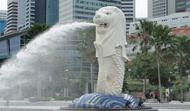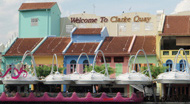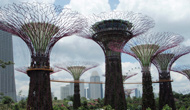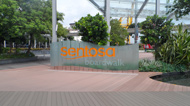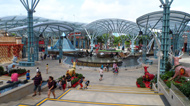 |
Singapore, officially Republic of Singapore is an insular State of south-est Asia, located on the south end of the malaysian peninsula; it is 152 Km. north of Equator. In the north it is separated from Malaysia by the Strait of Johor, in the south from the indonesian island of Riau by the Strait of Singapore. The State-town is the fourth main financial centre in the world and is one of the main cosmopolitan towns on earth, with an important role of international trade and finance, and its port is among the first five for activity and traffic worldwide.
Singapore is a country with a long history of immigration. Its varied population of about 5 million inhabitants is mainly composed by Chinese, Malay, Indians and other descendants from Asia and Europe. 42% of the population is foreign, here for work or study. The foreign workers form 50% of the services sector. Singapore is the second more densely populated country in the world after the Principality of Monaco, and in 2009 reached the highest concentration of millionaires in comparaison of the population, in front of Hong Kong, Switzerland, Qatar and Kuwait. At present its surface is about 641 sq. Km.
The name Singapore comes from the name in Malay language Singapura (Sanskrit: सिं"हप The lion town").
The town is also named with the common noun of Lion City.
Studies indicate that lions probably never lived in this region and the beast seen by Sang Nila Utama, founder of Singapore, was perhaps a Malaysian tiger. The flag of Singapore consists of two horizontal stripes, red on white. The red symbolizes the universal brotherhood and the equality between people; the white symbolizes the purity and the virtue. In the upper left corner there are a sickle half moon with opening towards the right, with five stars arranged in circle.
In August 1963, Singapore declared the indipendence from the British Commonwealth, and united to the Malaysian Federation. One year later, in 1964, due to various political problems, the new federation failed and the 9th of August 1965 Singapore was expelled from the Federation becoming the Republic of Singapore, with Lee Kuan Yew as Prime Minister of the new born state and Yusof Bin Ishak President of the Republic. Pragmatic and clever, Lee gave life to a government based on the modernisation at any cost and with the suppression of the political opposition. He officially made of Singapore a democratic country, but in fact he trasformed it into a kind of covered dictatorship, with a massive secret police devoted to empeach the political opponent and to obstruct the free elections, furthermore he aimed to a strong homologation, with advertising campaigns and forbidding some behaviours considered as normal in the rest of the "western" world, like for instance to chew o have long hair. In exchange he made of the materialistic capitalism a kind of lay religion of the state, bringing a wealth strongly consumerist to the island-state. He resigned as Prime Minister only in 1990; he was succeeded by Goh Chok Tong, a more democratic and liberal leader. The first presidential election of the country took place in August 1993; before then the president (whose role is essentially of representation) was elected by the members of the parliament. The most recent presidential election dates back August 1999, when the victory was of Sellapan Rama Nathan. The last general elections for the parliament date back May 2011. In 2004 Lee Hsien Loong, the eldest of Lee Kuan Yew, became the Prime Minister. So far the true democracy of Singapore is to be proved and the elections definitely seem manipulated by the very strong control on the media and the same opposition hold by some families, above all the family Lee; till when the economic conditions remain excellent, it is difficult that there will be riots against this state of things, as on the contrary happened in the near states. Among his initiatives, the plan of casino opening to ecourage tourism.
Singapore is an insular state made up of 63 islands. The main island is known as Singapore island, but is officially called Pulau Ujong (Malay language: transliterated as island at the end of the earth, intended as Malay peninsula). On the south of the Malacca peninsula there are two artificial connections, with Johon in Malaysia: the Johor-Singapore causeway in the north and the so called Malaysia-Singapore second link in the west. The islands of Jurong, Pulau Tekong, Pulau Ubin and Sentosa are the biggest among the minor islands of the archipelago.
The highest natural point is the Bukit Timah hill located 166 meters over the sea level.
Singapore has in progress projects that foresee to reclaim land from its hills, from the sea floors and from the neighbouring countries. As result the surface of Singapore grew from the 581.5 sq. Km. in 1960 to the 712 sq. Km. in 2010. The assessment is that the surface of the country can grow of other 100 sq. Km. within 2030. The projects sometimes involved some of the minor islands, that have been united together through the reclamation work of the territory, giving life to bigger and more functional islands, as the case of Jurong island. In the past the urban area was concentrated in the south part in correspondance of the mouth of the Singapore river where at present the town centre is located (the area called Downtown Core), whereas the remaining part of the territory was covered by tropical forest. From the 60ties the government built different residential areas in the suburban zones, that in the meantime expanded giving birth to a single urban area. The Office that deals with the urban planning is called Urban Redevelopment Authority. Singapore has a developed market economy. With Hong Kong, South Korea and Taiwan towards the end of the '90ties of the XX century Singapore was considered as one of the four Asian tigers. The economy strongly depends from the export, in particular in the manufacturing sector, which made up the 26% of the GDP in 2005 and includes electronics, oil refinement, chemistry, mechanical engineering and the biomedical sciences. Singapore has one of the busiest ports in the world and is the fourth main financial centre of trade exchanges after London, New York and Tokyo. The World Bank classified Singapore in 2007 as the most important hub in the world for logistics. The economy of Singapore is classified as among the ten more free and competive. Singapore employs also hundreds of thousand of foreign workers, is a popular travel destination at international level, contributing to a growing turistic industry. The total arrivals came to 10.2 millions in 2007. To attract more turists the goverment decided to legalize the game of chance and a great number of casinos are now in the Marina Bay area.
The food is another successful element to attract turists, with the Singapore Food Festival which takes place every July in order to celebrate the Singapore cuisine.
The local currency is the Singapore Dollar represented by the symbol S$ or by the international initials SGD. The central bank is the monetary authority of the country, responsible for the emission of banknotes and coins. Singapore established the Council of Exchange Commissioners in 1967, that from then started to issue local currency.
The Singapore Dollar has been exchanged as Malay Ringgit till 1973. On the contrary the interchangeability has been kept with the Brunei Dollar. The 27th of June 2007, to commemorate the 40 years of monetary agreement with Brunei, has been issued a commemorative banknote of S$ 20; the back is the same of the Brunei banknote issued the same day. For historical reasons the national language of Singapore is Malay, utilized also for the national anthem. Other official languages are: English, Chinese Mandarin and Tamil. From the indipendence English is the official language used by the public administration and is also widely spread among the population. The traffic signs and official publications are written in English, often accompanied by the translation in another of the official languages. The English used is the British with american influences, the local and dialect forms of the English is the so called Singlish which has many features in common with creole languages, having incorporated terms and grammar forms from Chinese, Malay and Indian dialects. Singlish is spoken in the everyday life but is disliked in the official occasions. Singapore has one of the best medical systems in the world, although the health expenses are relatively low for developed countries. Singapore is a parliamentary republic governed according to the Westminster system, the parliament is unicameral, expression of electoral colleges. Its constitution establishes the representative democracy as adopted political system.
The ONG Freedom House has classified Singapore as "partially free" in its report Freedom in the World and the Economist considers Singapore as a "mixed regime". Singapore is considered as one of the least corrupted countries in the world by Transparency International. The death penality is still in force. In a survey in 2008, international corporate executives considered that Singapore with Hong Kong had the best legislative system in Asia.
To reach Singapore from KL it is possible to use, besides the plane and the train, a very efficient and confortable service of luxury bus which in about 6.5 hours link the two towns: Five Stars, Grassland and others. The price is about 45 RM from KL with Five Stars (www.fivestarsonline.com, enquiry@fivestarsonline.com) whereas it is 42 S$ from Singapore with Grassland (www.grassland.com.sg). It is possible to book online or directly at the agency along Beach Road in Singapore, and in KL at BTS.
Singapore is perhaps the least oriental of the Asian metropoles, called the "garden town" for its large tropical parks, it is a very tidy town projected to the future, where the different cultures and religions live together in harmony. The town faces a futuristic port full of life, and this former British colony attracts thanks to its modern architecture and the amazing tradition.
The area of Marina Bay offers one of the most fascinating and spectacular skylines in the world: a moltitude of modern and imposing skyscrapers reflect on the waters of the river, the shining Esplanade dominates the Bay with its futuristic and extravagant form, whereas along the jetty appears the Merlion, the lion statue symbol of Singapore. The most pleasant and characteristic way to visit the area is to go along the river on a boat, with the night lights. The impact getting near Marina Bay is really fantastic and with the sparkling lights it seems a town of the future. Behind the Marina is located one of the most luxury hotels in the world: the Fullerton Hotel.
No doubt Singapore' s Chinatown is not among the more authentic and characteristic of the Far East, with the skyline of skyscrapers on a background of stained houses with an architecture that riminds the Old-Cuba, yet the small silk and material shops, the stalls with oriental food, make of this area a pleasant place where to walk. And then there are temples, hidden among the buildings, high and narrow, finely decorated inside where is hidden a unique atmosphere. The main street, Pagoda street, is completely pedestrian and always full of people, with ancient herbalist's shops that propose the traditional chinese medicine, one of the most ancient in the world, among strange ointments, roots and acupucture.
The most important building in China Town is Sri Miriamman, the most ancient hindu temple in town. The facade is the classical one of the hindu temples, a high tower made up of deities that rises to the sky. The temple is dedicated to the goddess Sri Miriamman and every year takes place the Thimithi Holiday, with some devotees that walk on the burning coals. The inner side is larger than the narrow entrance. You have to walk in barefoot and it is easy to run into curious rites made up of involving songs, sounds, priests who offer gifts to the deities. The whole among pagoda roofs finely decorated, giant colorful dragons and shrines of any kind.
Clarke Quay is one of the most lively areas in Singapore, directly located on the river, it boasts an infinite number of places and restaurants in a position to offer a culinary round the world trip, covering between the Chinese, Indian and Malay cuisines, but also with western tastes. In particular, it is possible to taste the fresh fish at moderate prices. Some restaurants have been arranged on the typical balconies over the river, whereas most of the restaurants are in the typical lanes where every evening take place shows, entertainment and concerts.
The area is definitely modern, offers wonderful views over the skyscrapers of Singapore and the atmosphere is very involving.
The town is also famous for its capacity of integration among the different cultures and religions, just enough that sometimes a block is enough to divide Muslim from Hindu, Chinese from Malay. Little India is a very charateristic area where the indian community lives. The quarter is characterized by a moltitude of hindu temples, among which the most fascinating is surely the Srinivasa Penumal, that strikes due to its rich decorations and the charming cerimonies and rites.
The streets are invaded by the people that walk along the different souvenir shops,
among the cheapest in town, as well as restaurants that propose the indian deliciousness. If you have the intention to make shopping in Singapore, surely this is the most convenient area.
In the centre of the typical zone of Kampong Glam, a typically Arab area in the heart of Singapore, rises the imposing Masjid Sultan, the most famous mosque
thanks to its golden dome and the high minarets. It is possible to get in with the only restriction not to enter the pray room and with decent clothes. Yet, the interior is very simple and rather disappointing, the beautiful external facade is much more striking. The mosque is surrounded by the pleasant pedestrian zone of Bussorah Mall, a completely paved street where it is possible to walk and make shopping in the small shops which propose a variety of arab products, from the carpets to the classic fabrics. Singapore is one of the capitals of shopping and its commercial soul is Orchard Road, with numberless modern commercial centres, advertising screens and luxury hotels, where it is possible to walk on huge pavements full of tropical flowers. In the nearby there is also the National Museum of Singapore, to redescover the history and the town culture.
The National Orchid Garden is inside the Royal Botanical Garden, a vast green area just a few minutes from the centre.
Walking along the luxuriant garden it is possible to admire over 400 species of orchids, the biggest exhibition in the world, scattered in a charming environment made up of artificial waterfalls, small hills and bridges.
The island of Sentosa, integral part of Singapore, is a combination between amusement park, attractions and artificial contructions that prevail over a natural environment composed by beaches, sea and tropical jungle. Among the attractions there is the 4D Magix, realistic multimedia cinema and the Tiger Sky Tower, a panoramic breathtaking descent from a dizzy height. Some paths get lost in the tropical jungle, among which there is a suggestive course among oriental temples and dragons of the Nature Walk. Very pleasant is also the Sentosa Luge and Skyride, a descent of 800 meters by go-kart. From Beach station it is possible to reach the beaches of the island, strictly artificial, as the white Palawan Beach. In the nearby there is the Dolphinarium where it is possible to enjoy the acrobatics of the rare pink dolphins, with an entrance ticket that includes the visit to the acquarium of Underwater World, on the other side of the island and reachable by bus.
Practical information: from the centre there are two ways to reach the island, in addition to the public buses: the most confortable one is surely the monorail that, apart to cover the expanse of sea which separates Sentosa from Singapore, has also two stations on the island itself, to confortably reach all the places. The most charming way to reach Sentosa is the cablecar suspended over the sea that leaves from Mount Faber, offering panoramas over the town and over the famous port of Singapore.
The new icon of Singapore is the Marina Bay Sands. With the casino, the resort has a hotel, a convention centre, a commercial centre, a museum of art & science, two theatres, seven restaurants, two floating crystal pavillions and a skating rink. The complex is
surmounted by a suspended platform in the shape of a ship called SkyPark (340 meters long) where there are roof gardens, jacuzzi, spa, bars and restaurants with a capacity of 3.900 people, and at a height of 150 meters there is a swimming pool (the highest in the world).
The resort was officially opened with two days of celebration the 23rd of June 2010, after a partial opening the 27th of April 2010. The SkyPark opened the following day the 24th of June 2010. The theatres have been completed on time for the first performance of Riverdance the 30th of November 2010.
The opening of Marina Bay Sands took place the 17th of February 2011.
The 3rd of March the first performance The Lion King took place .
The bet of Singapore is hard and stimulating at the same time: to challenge the troubles of the country, one of the places with the highest housing density in the world, through the development of a green town planning and engineering, that can bring advantages in term of quality of life and environmental protection. One of the symbol projects of this philosophy is Gardens by the Bay, opened in 2012 and already become the new icon of this city-state, thanks to his Supertree Grove. The Supertree Grove, integral part of the Gardens, sums up a futurist vision of the relation with the nature: vertical gardens, from 25 to 50 meters high that seem to arrive from another planet with caps and frames provided with photovoltaic panels which guarantee an energy-saving lighting and the energy indipendence of the gardens. The "supertrees" are built in perforated cement and steel and "shelter" nearly 163.000 plants and more than 200 species of flowers. This flora completely permeates the big structures which support the big umbrella foliages, transforming them into bio-structures. Besides the solar panels, on the super-trees are installed systems to collect rain water for the plants and a geothermal system that guarantees the sustainability of the Super-trees. The extraordinary beauty of this "bio installation" in interlaced with its utility: besides to be completely indipendent from an energetic point of view, it helps to give shadow to the below gardens and to maintain the right temperature in the park. But, during the night, their play of light creates a surprizing skyline. To increase the emotion it is possible to try the OCBC Skyway, "aereal footbridge" which links some trees and is suspended thanks to some steel cables: this is part of a grid course, which allows to watch either on the forest and also on all the trees of the Singapore bay. But the Supertrees are only a part, even if it is the most spectacular, of the Gardens by the Bay. The gardens, as a matter of fact, have a surface of 101 hectares, of which 17.000 meters are covered, thanks to the presence of two huge glasshouses, bioclimatic and sustainable, that give shelter to rare species impossible to grow in the sultriness of Singapore: the Flower Dome and the Cloud Forest. The Flower Dome is planned for mediterranean and half dry climates: efficiently conditionned, due to the dry temperatures of Singapore. Among the "open space" glasshouses, without separations of environments, this is the biggest in the world. On the contrary, Cloud Forest recreates the environment of a rain forest at a height of 2.000 meters. Not only the temperatures and the fauna: even the sounds, thanks to the artificial waterfalls, recreate the landscape of a high mountain. On the end, in the Gardens there are two other very particular attractions: the World of Plants and the Heritage Gardens. The first on the south of the Supertrees, is a teaching course which thanks to the passage through six gardens, allows to understand the biology and the development of different kinds of plants and mushrooms. The Heritage Garden, last incredible attraction, is a collection of four theme gardens: Indian, Chinese, Malay and Colonial. The Heritage, which flows under the northern part of the Supertrees Grove, has a precise purpose that connects ecology and culture: while walking across every garden, it is possible to descover the cultural contributions of the different ethnic groups that allowed Singapore to be the town of today.
Practical information: to move in Singapore it is possible to use the taxi, not expensive at all. The starting price is 3 S$ and hardly you spend more then 10 S$ in town, even by night. Another choice is the MRT, the very modern metro of Singapore that with its various lines covers the whole island. The ticket price varies according to the number of the stops, from 1.30 S$ to 2.10 S$. You must keep in mind that Singapore is also called the "fine town", consequently you have to pay big attention to the different prohibitions (to eat in the metro, to spit, to chew, to throw a paper, etc.) and this makes of it the cleanest town in the world.
Currency in Singapore: Dollar of Singapore (S$)
Exchange rate on the 21 December 2013:
1 € = 1,70 S$ - 1 USD = 1,26 S$
Hourly difference with Italy: + 7 hours (solar time)
